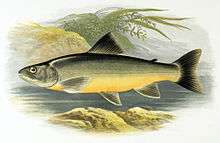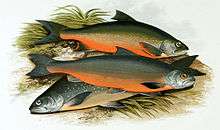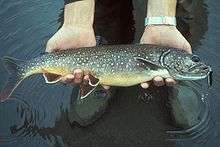Salvelinus
| Salvelinus Temporal range: Late Miocene - present[1] | |
|---|---|
| | |
| Arctic char, Salvelinus alpinus alpinus | |
| Scientific classification | |
| Kingdom: | Animalia |
| Phylum: | Chordata |
| Superclass: | Osteichthyes |
| Class: | Actinopterygii |
| Subclass: | Neopterygii |
| Infraclass: | Teleostei |
| Superorder: | Protacanthopterygii |
| Order: | Salmoniformes |
| Family: | Salmonidae |
| Subfamily: | Salmoninae |
| Genus: | Salvelinus J. Richardson, 1836 |
| Type species | |
| Salvelinus umbla (Linnaeus, 1758) | |
| Species | |
|
See text | |
Salvelinus is a genus of salmonid fish often called char[2] or charr; some species are called "trout". Salvelinus is a member of the Salmoninae subfamily of the Salmonidae family. The genus has a northern circumpolar distribution, and most of its members are typically cold-water fish that primarily inhabit fresh waters. Many species also migrate to the sea, however.
Most char may be identified by light-cream, pink, or red spots over a darker body. Scales tend to be small, with 115-200 along the lateral line. The pectoral, pelvic, anal, and the lower aspect of caudal fins are trimmed in snow white or cream leading edges.
Many members of this genus are popular sport fish, and a few, such as the lake trout (S. namaycush), are the object of commercial fisheries and aquaculture. Occasionally, such fish escape and become invasive species.
Deepwater char are small species of char living below 80 m in the deep areas of certain lakes. They are highly sensitive to changes in the quality of the water and some species, such as Salvelinus neocomensis and Salvelinus profundus, were driven recently to extinction.[3]
Species diversity
As with other salmonid genera, the delimitation of species in Salvelinus is controversial. FishBase in 2015 listed 54 species or subspecies in this genus, many of which have very narrow local distributions.[4] Fourteen localised species are listed from the British Isles alone, although these traditionally, and still by the national conservation and fisheries authorities, are all considered to represent the widespread Arctic charr (S. alpinus). Twenty species are listed from the Asian part of Russia, including several localised taxa from in each of the Kamchatka, Chukotka and Taimyr peninsulas. One of these is the long-finned char, which phylogenetically is part of the Salvelinus group although it has been so far classified into another genus Salvethymus.[5]
The Arctic char (S. alpinus) is the most broadly distributed Salvelinus species. It has a circumpolar distribution, and it is considered the most northern of all freshwater fishes. In North America, five relatively well defined species are present, which, apart from the Arctic char, comprise the brook trout (S. fontinalis), bull trout (S. confluentus), Dolly Varden trout (S. malma) and lake trout (S. namaycush).
This listing presents the taxa recognised in FishBase grouped by geography:
Circumpolar
- Salvelinus alpinus (Linnaeus, 1758) – Arctic char
Europe
- Central Europe
- Salvelinus evasus Freyhof & Kottelat, 2005
- Salvelinus umbla (Linnaeus, 1758) – lake char
- †Salvelinus neocomensis Freyhof & Kottelat, 2005
- †Salvelinus profundus (Schillinger, 1901)

- British Isles
Scotland and adjacent islands:
- Salvelinus gracillimus Regan, 1909
- Salvelinus inframundus Regan, 1909
- Salvelinus killinensis (Günther, 1866)
- Salvelinus mallochi Regan, 1909
- Salvelinus maxillaris Regan, 1909
- Salvelinus struanensis (Maitland, 1881)
- Salvelinus youngeri (Friend, 1965) – golden char

England and Wales:
- Salvelinus lonsdalii Regan, 1909
- Salvelinus perisii (Günther, 1865)
- Salvelinus willoughbii (Günther, 1862)
Ireland:
- Salvelinus colii (Günther, 1863)
- Salvelinus fimbriatus Regan, 1908
- Salvelinus grayi (Günther, 1862)
- Salvelinus obtusus Regan, 1908
- Northern Europe
Iceland and Atlantic islands:
- Salvelinus faroensis Joensen & Tåning, 1970
- Salvelinus murta (Sæmundsson, 1909)
- Salvelinus thingvallensis (Sæmundsson, 1909)
- Salvelinus salvelinoinsularis (Lönnberg, 1900) – Bear Island char
Fennoscandia and Northwest Russia:
- Salvelinus lepechini (J. F. Gmelin, 1789)
Asia
- Arctic drainages
- Salvelinus andriashevi L. S. Berg, 1948 – Chukot char
- Salvelinus boganidae L. S. Berg, 1926 – Boganida char
- Salvelinus czerskii Dryagin, 1932 – Cherskii's char
- Salvelinus drjagini Logashev, 1940 – Dryagin's char
- Salvelinus elgyticus Viktorovsky & Glubokovsky, 1981 – small-mouth char

- Salvelinus alpinus erythrinus (Georgi, 1775) – davatchan
- Salvelinus jacuticus Borisov, 1935 – Yakutian char
- Salvelinus taimyricus Mikhin, 1949
- Salvelinus taranetzi Kaganowsky, 1955 – Taranets char
- Salvelinus tolmachoffi L. S. Berg, 1926 – Lake Yessey char
- [Salvethymus svetovidovi Chereshnev & Skopets, 1990 – long-finned char: phylgenetically part of the Salvelinus clade[5]]
- Pacific drainages
- Salvelinus albus Glubokovksy, 1977 – white char
- Salvelinus curilus (Pallas, 1814) (= S. malma krascheninnikova Taranetz, 1933 – southern Dolly Varden
- Salvelinus gritzenkoi Vasil'eva & Stygar, 2000


- Salvelinus krogiusae Glubokovksy, Frolov, Efremov, Ribnikova & Katugin, 1993
- Salvelinus kronocius Viktorovsky, 1978
- Salvelinus kuznetzovi Taranetz, 1933
- Salvelinus leucomaenis (Pallas, 1814) – whitespotted char
- S. l. leucomaenis (Pallas, 1814)
- S. l. imbrius D. S. Jordan & E. A. McGregor, 1925
- S. l. pluvius (Hilgendorf, 1876)
- S. l. japonicus (=S. japonicus) Ōshima, 1961 – kirikuchi char
- Salvelinus neiva Taranetz, 1933 – Neiva
- Salvelinus schmidti Viktorovsky, 1978
- Salvelinus vasiljevae Safronov & Zvezdov, 2005 – Sakhalinian char
North America

- †Salvelinus agassizii (Garman, 1885) – silver trout
- Salvelinus confluentus (Suckley, 1859) – bull trout
- Salvelinus fontinalis (Mitchill, 1814) – brook trout
- Salvelinus malma (Walbaum, 1792) – Dolly Varden trout
- "Salvelinus anaktuvukensis" Morrow, 1973 – angayukaksurak char (= S. malma)
- Salvelinus namaycush (Walbaum, 1792) – lake trout
Hybrids
- S. alpinus × S. fontinalis – Alsatian char
- S. namaycush × S. fontinalis – splake, brookinaw
- S. fontinalis × Salmo trutta – tiger trout
- S. leucomaensis x O. masou – river mackerel, Kawasaba
References
- ↑ Sepkoski (2002)
- ↑
 Chisholm, Hugh, ed. (1911). "Char". Encyclopædia Britannica. 5 (11th ed.). Cambridge University Press. p. 855.
Chisholm, Hugh, ed. (1911). "Char". Encyclopædia Britannica. 5 (11th ed.). Cambridge University Press. p. 855. - ↑ Red List - Volume 1: Vertebrates (2009) - General assessment for the vertebrate groups
- ↑ Froese, Rainer, and Daniel Pauly, eds. (2015). Species of Salvelinus in FishBase. May 2015 version.
- 1 2 Alexander G. Osinov, Anna L. Senchukova, Nikolai S. Mugue, Sergei D. Pavlov, Igor A. Chereshnev (2015) Speciation and genetic divergence of three species of charr from ancient Lake El'gygytgyn (Chukotka) and their phylogenetic relationships with other representatives of the genus Salvelinus Biological Journal of the Linnean Society 116, 63–85.
- Sepkoski, Jack (2002): Osteichthyes. In: A compendium of fossil marine animal genera. Bulletin of American Paleontology 364: 560. HTML fulltext
External links
 Media related to Salvelinus at Wikimedia Commons
Media related to Salvelinus at Wikimedia Commons- USGS Nonindigenous Aquatic Fish Database
- IUCN Salvelinus umbla